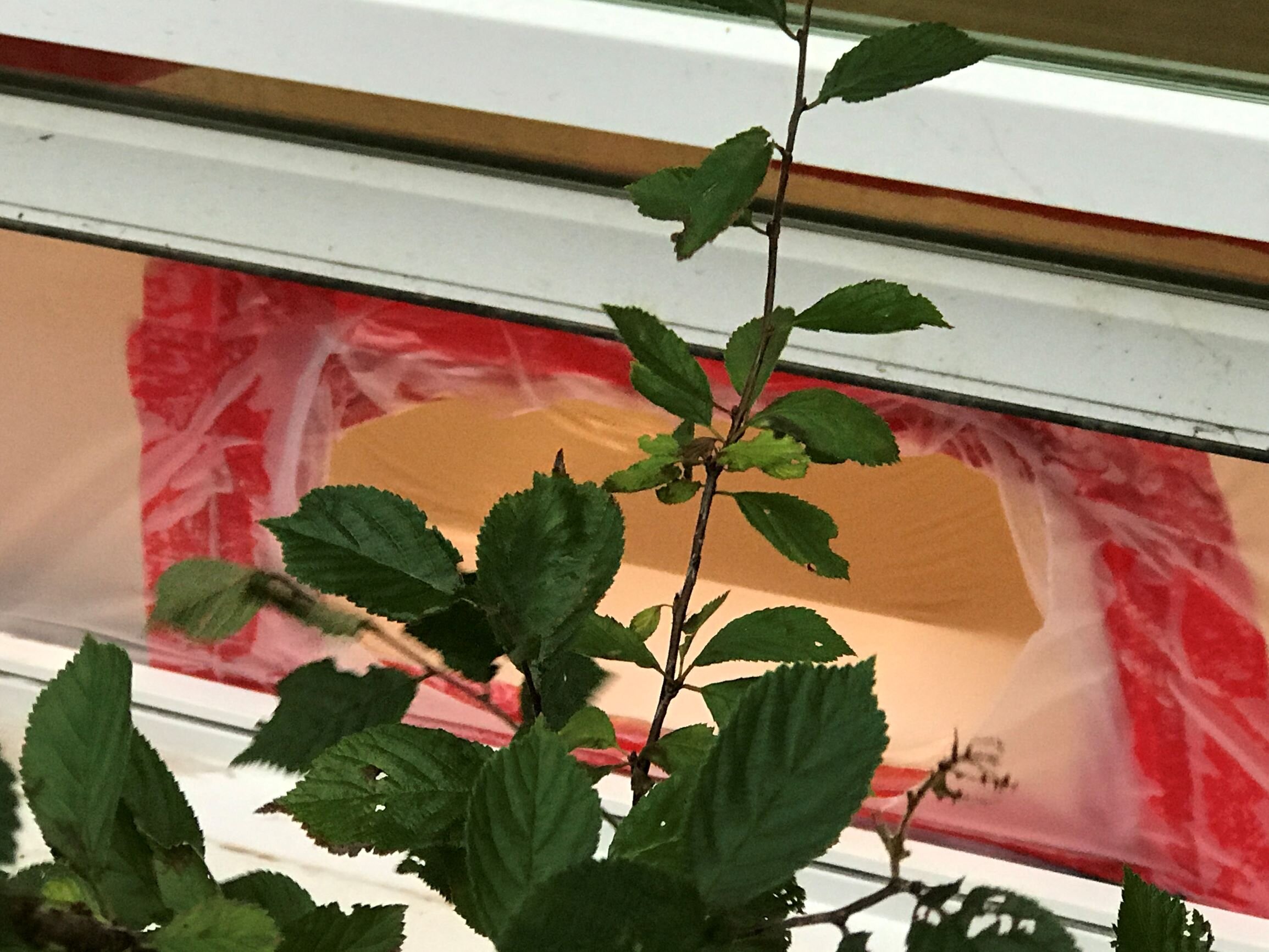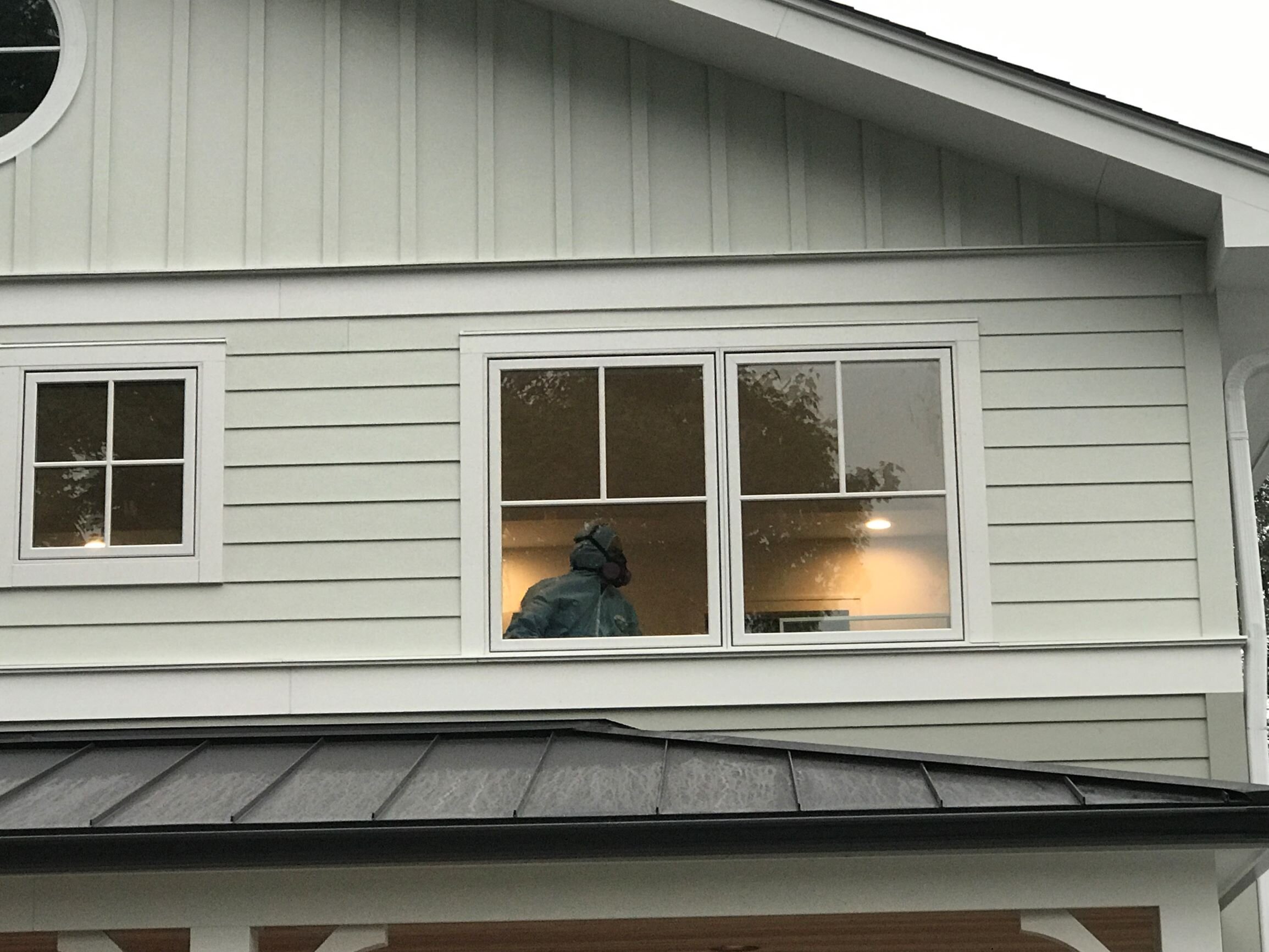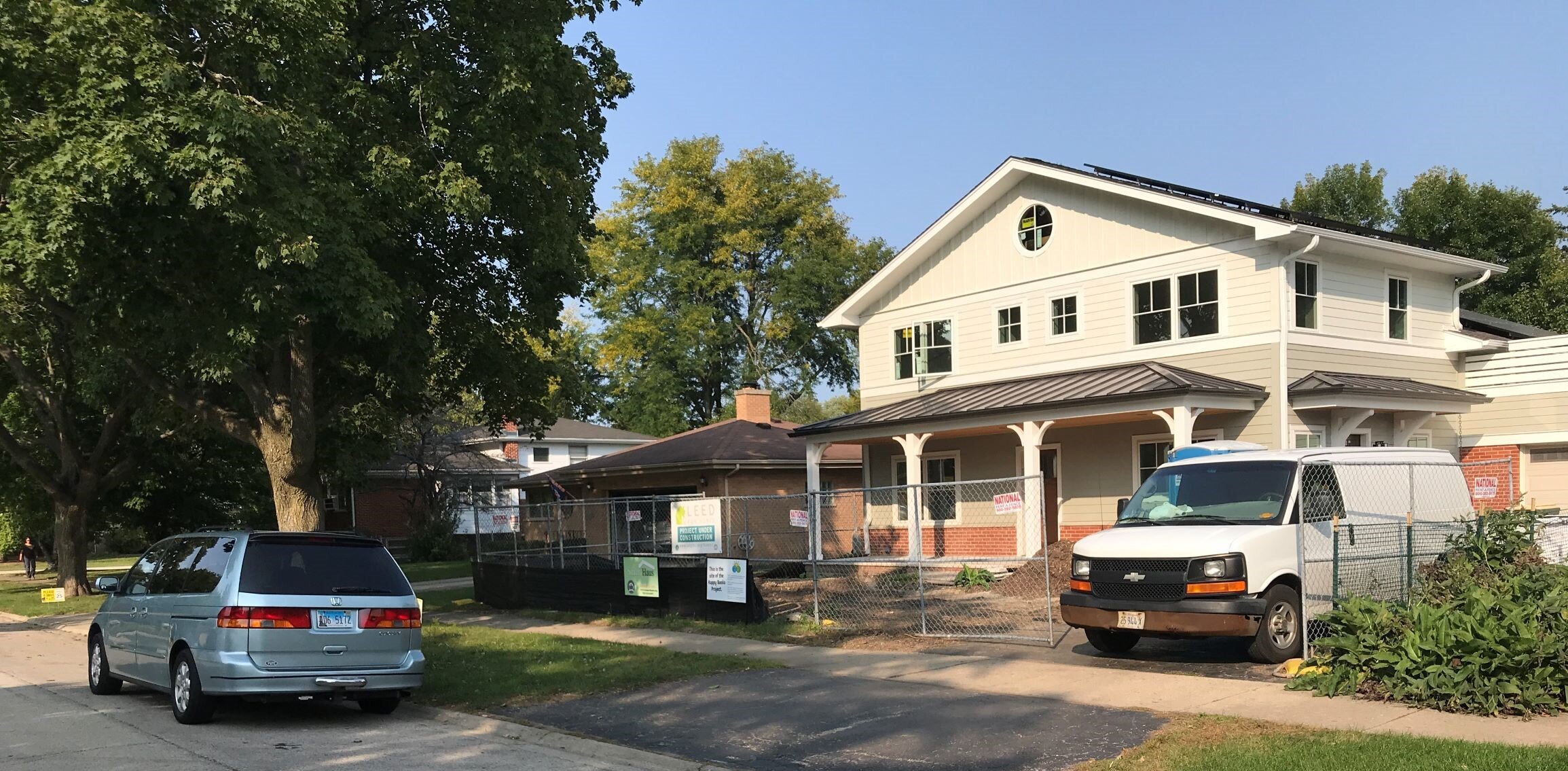But everything was moving along smoothly…
August 2020:
The middle of August 2020 found The Happy Boolo Project in a good place. We’d finished with drywall, and thanks to efficient scheduling, we were about to start with our new wood flooring in the kitchen, radiant floor heating and tile work in the master bathroom, interior doors, and have our CERV (ventilation system) installed.
Outside, the air was warm and our solar panels were just about to come online.
Amy and I were at the house early on a bright, sunny Wednesday, August 12th.
Amy was going to spend the morning documenting on-going construction, while in the backyard, I was going to cut willow and hazel before heading back up the street to login for work.
Flooring and doors standing by…
Radiant heated floor prep begins…
CERV awaiting installation…
That’s when we heard jack-hammering coming from inside the house.
Amy came around to the back just as I was listening to the sound.
“Hey… do you hear that? They’re jackhammering in the utility room,” she said.
I looked at her, but didn’t fully process what she was saying — I was focused on the upcoming landscaping and rainwater harvesting design.
We went inside… sure enough, the floor tile in the utility room had been jackhammered in order to — now I remembered — remove the broken trap in the floor drain.
But something still seemed out-of-place.
In a flash, my memory raced back to conversations, decisions, and learnings from months and years before that day in August…
During our design phase in late 2019, Amy and I had been discussing the overall flooring plan with our architect. The plan was to replace the carpet in our family room and basement landing with a floating synthetic floor which would match the hardwood floor aesthetic in other rooms.
When we’d replaced the original carpet back in 2002, we were asked if the tiles under the carpet were asbestos, but we didn’t know. At the time, we were such newbie homeowners, we really didn’t know what the deal was with asbestos. There was no asbestos disclosure in our closing in 2000.
About 15 years ago, a plumber responding to our concern about a stinky smell in the utility room told us the trap in our utility room floor drain was likely cracked, allowing water to drain out the bottom instead of remaining in the trap, which was supposed to block sewer gas from coming up into the room through the drain.
He advised us to pour a cup of water down the drain and then apply a few drops of mineral oil to “seal” the surface of the water.
This was the “permanent” temporary solution we employed leading up to the start of The Happy Boolo Project.
So, once we decided to replace the carpet in the family room and landing with a floating floor, the discussion turned to the utility room floor — would that be a floating floor, too?
The answer was yes — to maintain the same aesthetic. Sounded fine to us.
But that’s when I remembered the floor drain in the utility room and suggested that it would be great if we could get that fixed before the new floor was installed.
We also had talked about what LEED requires as far as asbestos — we were sort of surprised to learn that it doesn’t even mention it in its guidelines — but we considered having it tested and abated anyway because we felt that direction was aligned with our Boolo philosophy, so, in November 2019, our architect — who would be soon putting on his construction manager hat — referred us to an asbestos abatement professional, who explained that asbestos is only dangerous if you disturb it, so in our case, covering tile with a floating floor above it would not disturb any asbestos if it were actually contained within the tile. That’s when we figured “well, it’s OK to cover it.”
What also sealed our decision to not do anything about the tile was that our architect had asked our plumbing team to inspect the floor drain in January 2020 after we’d completed deconstruction, which stipulated that no tile was to be removed.
We were told “the plumbers said it looks OK — it’s draining normally.” That was a bit confusing, but we trusted the professionals.
With that, we thought we had a good plan — don’t disturb the tile and cover it with a floating floor.
And move on with the project!
Which brings us back to August 12, 2020…
Here we were observing this sudden disturbance in the utility room and then I realized:
Oh CRAP! They’re jackhammering up the tile!
I was confused. Why are they doing this now? We’d been told seven months ago that the drain was OK. Apparently, the plumbers had taken a second look — most likely because attention was now directed at installing the new ventilation system, which required a floor drain nearby into which to drain out excess humidity — and had told our construction manager a different story: the drain’s trap was indeed cracked and needed to be replaced.
So, the trap replacement was scheduled.
And we happened to be there the morning it happened.
Once our construction manager arrived on the scene, we asked “what about the tile in the utility room?”
He looked like he’d seen a ghost. That scared us a bit.
But it was considered a small disturbance that likely didn’t contaminate the room, much less the entire house, with asbestos fibers (that may not even be present in the now pulverized tiles).
We were all in shock for a few days, but work continued while we processed what do to, if anything.
Work continues… we process…
It wasn’t until that weekend that it dawned on us that even though this was considered a small disturbance — a 3-tile x 4-tile (or 27” x 36”) section broken out to replace the floor drain’s trap — our brand new ventilation system (and the brand new ductwork opening into the now dust-filled utility room) was also being connected and turned on for the first time. I had visions in my head of Arlington Heights’ first LEED home (and one of few LEED Platinum remodels in all of Chicagoland) having ductwork full of asbestos fibers circulating optimally throughout the house to ensure contamination in every corner of our dream home. And I couldn’t reconcile the fact that one of the hallmarks of our home’s LEED Platinum performance — superior indoor environmental quality — seemed totally unachievable by not addressing a potential asbestos situation.
That’s when it became absolutely clear to us that we needed to get in front of this right now for our own peace-of-mind as well as to uphold our Boolo philosophy.
We decided to go through the full-blown asbestos testing — and if need-be — full-blown abatement.
I kept kicking myself — I should have known better. I should have remembered faster. I could have stopped it. I should have been more in-the-know. I should have asked more questions.
But I wanted to kick others, too — didn’t the plumbers look closely at the drain seven months ago? We could have addressed this safely during deconstruction before any ductwork, insulation, or drywall had been installed! Didn’t our construction manager remember our plan to not disturb the tile? How did this happen?!
But our construction manager was apparently already kicking himself — we spoke early the next week and we three quickly aligned that we all needed to do the right thing here and start working on a solution.
The first step was to get the tile tested, which happened the next day. As we feared, the samples taken from the utility room as well as the family room both came back positive for containing asbestos fibers.
Once we had a positive test result, we had to stop all work in the house and be patient through the 10-day waiting period to receive a permit to do the abatement.
During the waiting period (officially “the notification period”), our second step was to decide on an abatement company.
We considered two companies: Bluestone Environmental and B&B Construction. Both spent significant time with us on the phone answering our questions and explaining the way they approached the work, which we found to be excellent customer service. We did find it interesting that they recommended different approaches to the work, but both proposals were quite thorough. This added to our overall impression that each asbestos situation is different and that the guidelines are not always clear-cut.
Once we decided on Bluestone Environmental, Ron Miller, our account point person, made sure we knew exactly what to expect each step of the way.
The third step was to prepare for the abatement crew to arrive.
Mike K, our construction manager, worked with his draftsman Nicholas and our HVAC team from Chase Mechanical to remove and clean the CERV, and clean up the house in preparation for the full abatement process.
Doing the right thing
Sweeping up
Moving the CERV upstairs
HEPA-vacuuming the CERV before covering
As we continued to talk with various people about asbestos, we did hear a range of perspectives, including some that reinforced that it was a small amount, and it was unlikely there would be issues in the long-run.
However, we were grateful that we had been resolute in wanting to uphold our philosophy and have a fully clean home for both ourselves and for others whom we would invite to gather in the home.
On September 10th, Bluestone Environmental arrived with full hazmat gear and started to seal up the house for the full abatement. This was the only time Amy could not be the behind-the-scenes photographer and videographer as she was used to simply popping in on any given day to capture work underway. She satisfied her passion for capturing the journey by taking many pictures from the outside, and fortunately, Bluestone took pictures from inside the house during their work.
In talking to the team, it was apparent they were dedicated to making sure our home was as clean as possible. They showed up super-early on the job site each day and walked us through what they were doing. Their team leader, Kareem, was invested in making sure his crew understood the importance of the work and that they worked as a team. After all, they are having to deal with a hazardous material on a day-to-day basis, so it’s important to have one another’s back.
Kareem answering some of our questions
Wiping down every nook and cranny
Big machines and suits — things are getting serious!!
Trying to be satisfied with just taking pictures from the outside!
Protecting the tub
It looks like a big mouth!
Fireplace protected
Wiping down the windows
HEPA-vaccing Amy’s office
Haz-mat Guy to the rescue!
Utility room tile abated
These guys love to start their work super-early!
We were very pleased with the work of Bluestone Environmental and would call them again if we ever had such an unfortunate event. We would also recommend B&B Construction, as they were very experienced and gave us lots of advice before we made our final decision.
After the abatement and cleaning was done, the house was tested for the presence of asbestos by Environmental Consulting Group/EMSL Analytical.
“All is clear”
Those were the most positive words we would hear on September 14th when we got the test result back and the go-ahead to restart the project.
Our architect-construction manager was back to work diligently calling all contractors back to the job. The hope for a move-in date by Thanksgiving (already a delayed date due to the pandemic, other work, and decisions Amy and I took longer to sort during the summer) was looking less and less likely but we maintained hope.
The result of this disturbance was not only a stoppage of any construction — August 18th to September 14th — but additional cost for which we had not budgeted. We were not looking forward to the conversation about cost with our construction manager but knew we had to have it. We discovered — a bit late in the game — that the carpet nails sticking up from the tiles in the family room would have had to have been removed anyway to install the new floor, so at some point that would have been a cost. We also were incurring an additional month’s rent due to this disturbance. We appreciated when Mike K recommended that he take responsibility for the cleaning while we paid for the abatement.
We certainly learned a lot from this experience and never wanted to go through this again. And we learned a bit about asbestos — enough to dispel a few myths (for a later blog post). We also learned to not be so harsh on ourselves; there is a time to take responsibility, and there is time to realize the limits of your knowledge as a homeowner. As we continue to remind ourselves of something Julie O, our designer, likes to say: “You can only make decisions with the information you have.”
During our many walks by the sealed up home, neighbors would ask us what was going on, express their sympathy for our slow-down and their support for our project. Thanks to Drury Lane for being the type of neighborhood that makes you feel at home when your own house isn’t feeling like home.
And thanks to all on the project who contributed to ensuring our Happy Boolo Project lives up to the sustainability pillar of our philosophy with pristine air quality!
Our house is happy again. Let the work begin!
























